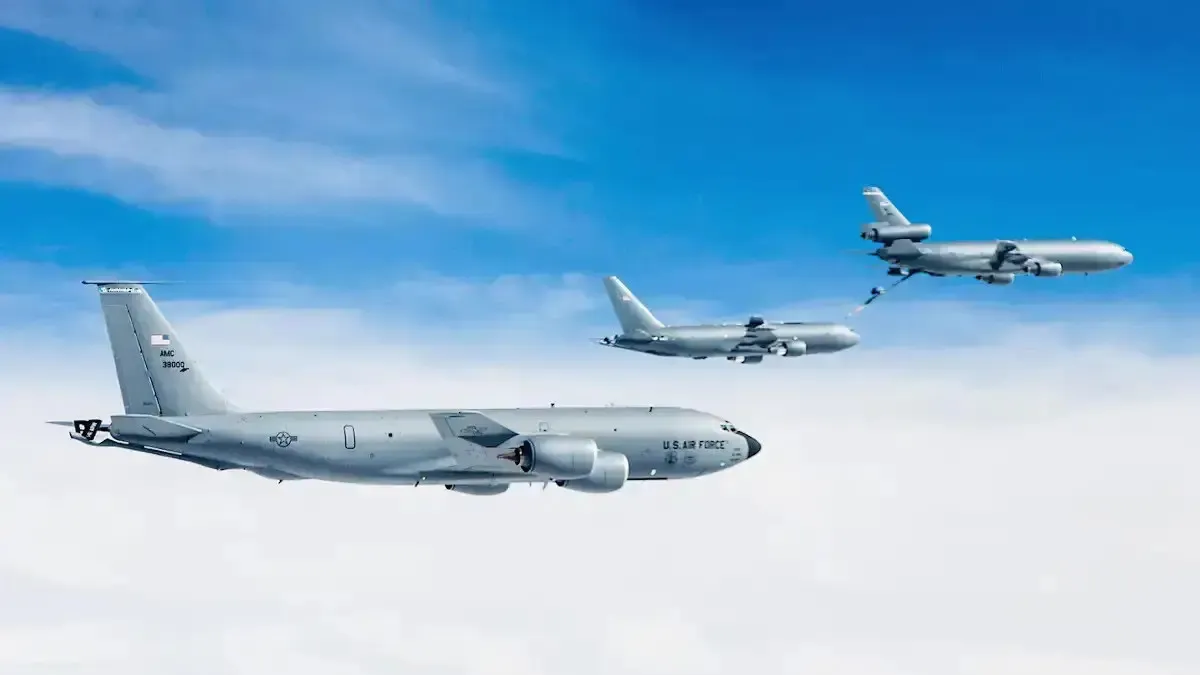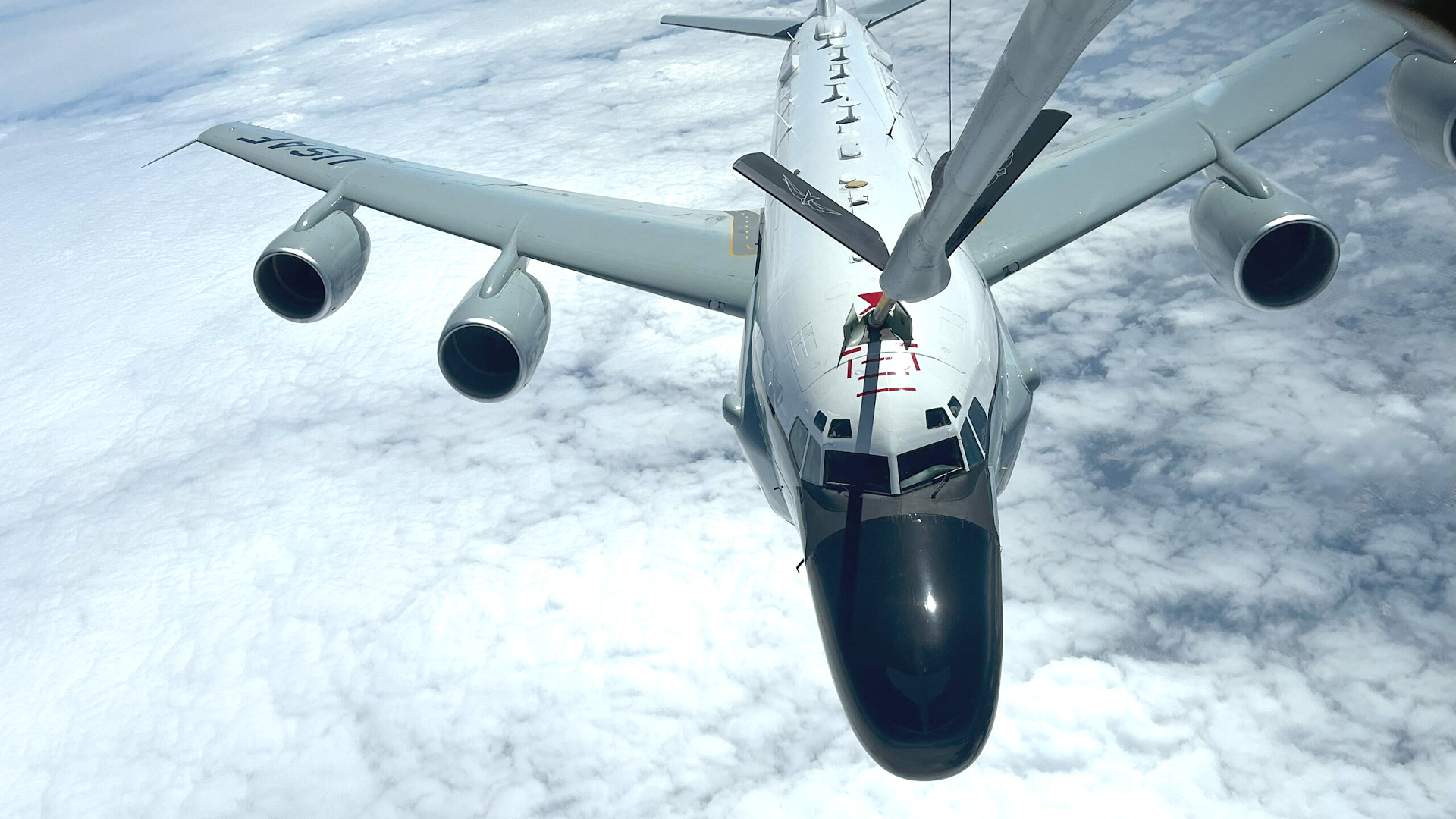A privately-owned KC-135R tanker refueled U.S. Air Force aircraft for the first time in a recent exercise. For years now, the service has been exploring the idea of using contractor-operated tankers for training and other non-combat missions to help ease the growing pressure on its organic tanker fleets.

Private aerospace firm Metrea announced the milestone in a press release, which says that the company’s KC-135Rs provided aerial refueling support during Exercise Resolute Hunter 23-2 to the Air Force. Resolute Hunter is a biannual U.S. Navy-led exercise and “is the DOD’s only dedicated Battle Management, Command and Control, Intelligence, Surveillance and Reconnaissance (BMC2ISR) exercise,” according to that service. The Air Force and foreign air arms routinely participate in the event, which is staged out of Naval Air Station Fallon (NAS Fallon) in Nevada.
“From June 23 through June 29, Metrea Strategic Mobility (MSM) provided four aerial refueling support missions for RC-135 [Rivet Joint] and E-3 [Sentry] aircraft,” according to the release from Metrea. “The total included 13 boom contacts and nearly 90,000 pounds of fuel offloaded, providing both aerial refueling training for the RC-135 and E-3 crews.”

The specific mention of boom contacts is important. Metrea is one of just two private companies that even own tankers of any kind configured with booms, the method by which the majority of Air Force aircraft are refueled in flight. The other is Omega Air Refueling, which still primarily operates tankers with probe-and-drogue refueling systems. Probe-and-drogue is the aerial refueling method for the U.S. Navy and Marine Corps, as well as many U.S. allies and partners abroad.

Previously known as Meta Aerospace, Metrea acquired four retired ex-Republic of Singapore Air Force KC-135Rs back in 2020. When those aircraft were purchased they were painted overall gray, as seen earlier in this story. Now they wear one of at least two multi-tone schemes that are broadly reminiscent of one the Air Force used on its tankers for a time in the 1980s and 1990s. That Air Force scheme had some general similarities to the shading of orca whales, leading to it being nicknamed the “shamu”.
Metrea became the first private company to actually transfer fuel to any other plane using a boom-equipped tanker in April when one of its KC-135Rs linked up with a Navy P-8A Poseidon maritime patrol plane – a notable exception to that service’s use of probe-and-drogue refueling systems.

Metrea’s KC-135Rs “are [also] equipped with two wing-mounted Multi-Point Refueling System (MPRS) pods which facilitate refueling with probe equipped Navy, Marine Corps and partner nation aircraft,” the company’s press release notes.
The video below shows a US Air Force KC-135R refueling Royal Australian Air Force F/A-18 Hornet fighters using wing-mounted probe-and-drogue pods.

Metrea is currently on contract with the Navy’s Naval Air Systems Command (NAVAIR), but it says that deal makes its KC-135R aircraft available to other branches of the U.S. military and America’s allies and partners in the course of training and other non-combat missions like helping aircraft make peacetime transits from one location to another. Unlike the Air Force, the Navy has long utilized other contractor-operated tankers to help provide this kind of aerial refueling support.
“It was fitting that we could support the U.S. Air Force in achieving this major milestone during the same week that we marked the 100th anniversary of aerial refueling,” Jon “Ty” Thomas, Head of Metrea’s Air and Space Group, said in a statement. “Our team worked closely with NAVAIR, Air Combat Command, and the receiver RC-135 and E-3 units to pull this off and deliver the training effect needed. We look forward to supporting more U.S. Air Force refueling requirements as well as increasing demand from allies and partners.”
The Air Force marked the 100th anniversary of aerial refueling on June 27. On that day in 1923, two modified de Havilland DH-4B biplanes belonging to the U.S. Army Air Service successfully demonstrated the concept of aerial refueling during a flight over California. You can read more about that event and the anniversary here.

Metrea is also sending one of its KC-135Rs to the Royal International Air Tattoo (RIAT) in the United Kingdom, which opens on Friday. The theme of this year’s iteration of that air show is “SKYTANKER23,” also in celebration of the aerial refueling anniversary.
Beyond the immediate significance of this milestone, the Air Force’s utilization of Metrea’s could have much further reaching impacts. The service is currently in the process of a complete overhaul of its tanker fleets.
Right now, the Air Force is continuing to acquire new KC-46A Pegasus aerial refueling tankers from Boeing and is in the process of divesting its entire inventory of older KC-10A Extenders. Its current plan is to eventually replace its own KC-135Rs with a mix of new, but more traditional tankers and an advanced and possibly stealthy type that will be developed under the Next Generation Air-refueling System (NGAS) program. The Air Force had talked in the past about holding a competition to acquire the additional more conventional tankers, but the service’s top leadership has indicated in the past year or so that it is leaning toward just buying more KC-46As.

However, the Air Force’s KC-46As have been beset by serious technical and quality control problems that have limited their true operational capabilities. A complete overhaul of the aircraft’s complex hybrid 2D/3D Remote Vision System (RVS) that operators in the main cabin use to guide the boom into receiving planes is in the works, but won’t be ready until 2025 at the earliest. The Pegasus’ boom itself needs fixing, as well. As an aside, the crews of KC-135s, like the ones Metrea flies, include boom operators who perform their work from a physical position look out the rear of the aircraft.

The issues with the KC-46A have already contributed to increased strain on existing tanker fleets. This, in turn, has long prompted concerns about the overall tanker capacity the Air Force would be able to bring to bear in a potential future high-end conflict, such as one against China across the broad expanses of the Indo-Pacific region.
For years now, the Air Force, together with U.S. Transportation Command, has been exploring alternative options for increasing tanker capacity, and more importantly boom tanker capacity. Contractors like Metrea have been brought up regularly in the course of those discussions, as The War Zone has highlighted in the past. The broad idea is that private firms could provide aerial refueling support for training and other non-combat tanks, and do so more flexibly and at lower cost, all while freeing up the Air Force’s own tankers for higher priority missions. You can read more about all of this here.
All told, Metrea’s KC-135 fleet refueling Air Force aircraft during Exercise Resolute Hunter could finally open a door of sorts to the service making greater use of contracted tanker aircraft in the future.
Contact the author: joe@thedrive.com
